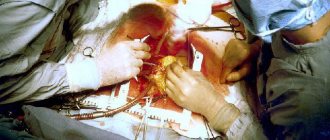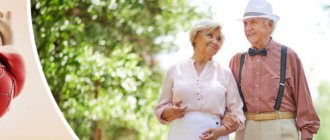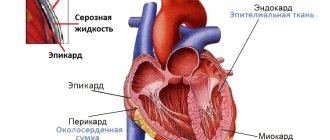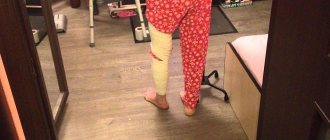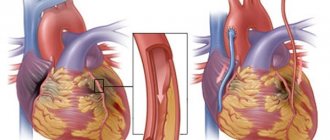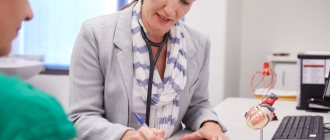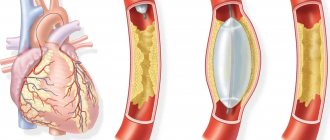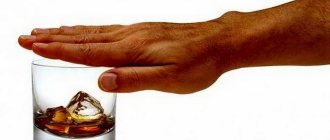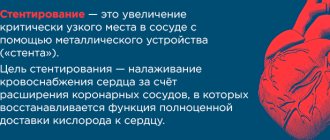Movement and breathing exercises
Gymnastics for the lungs after heart surgery
Registered: April 11, 2009, 15:46
User rating: 0
This complex must be performed several times a day.
In all exercises, you must inhale through your nose and exhale through your mouth.
It is important to take not only a deep breath, but also exhale as deeply as possible! The exhalation should be forceful, loud and three times longer than the inhalation. The starting position for all exercises is sitting, leaning your back against the back of a chair, and subsequently standing. Perform exercises smoothly and without overexertion.
1. Starting position - right hand at the top of the chest, in the center.
During inhalation, the chest should rise upward, and during
exhale - lower. The number of repetitions is 5 times (Fig. 1 and 2).
2. Starting position - arms symmetrically on both sides under the chest on
ribs: during inhalation, the chest expands to the sides, and during
exhale, squeeze it with your hands. Number of repetitions - 5 times. As you exhale, pronounce the sound “s-s-s” 3 times (Fig. 3 and 4).
3. During inhalation, the shoulders rise, and during exhalation, they fall.
The number of repetitions is 5 times (Fig. 5).
4. During inhalation, only the right or only the left shoulder rises 3 times
in a row (Fig. 6). (in 3 weeks)
5. During inhalation, the arms rise up 90 degrees. On the exhale
fall smoothly. Number of repetitions - 5 times (Fig. 7 and 8).
6. Place two hands on your stomach. During inhalation, the stomach must be inflated, and during exhalation, it must be retracted, helping with your hands. Quantity
repetitions - 8 times. Exhale and pronounce the sound “sh-sh-sh” 5 times
7. Inflate the balloon in a minimum number of repetitions (exhalations). Every hour 1-2 times.
8. Starting position - sitting. Long exhale into the bottle through
tube for a while. Try to exhale continuously for seconds.
Number of repetitions 3-5 times.
This sheet with exercises was given to me at Bakulev.
I still exercise (though I don’t do all the exercises). These exercises are very useful for those who have reduced vital capacity (lung capacity)! Hope it's useful to someone!
Registered: 18 Nov 2013, 00:34
You do not have permission to post messages to this topic.
Complement breathing exercises with physical exercise and self-massage. When you wake up after surgery, the first thing you do is try to move. Start with small movements.
Close your eyes tightly and then open your eyes wide. Stick your tongue out as much as possible and then hide it. Puff out your cheeks and “wiggle your mustache.” Move your jaw and chatter your teeth.
Clench your fists forcefully and then spread your fingers. Clench your fists and roll them around your wrist joints.
Move your feet as if you were standing on your tiptoes and then back down on your heels. Bend your knees, pull your heels towards you one by one, and then straighten your legs one by one.
Try to do something like a “bridge”: bending both legs at the knees and resting your heels and shoulder blades on the bed, try to lift your buttocks off the bed.
Exercise several times a day as soon as you feel your body stiff. The acceptable pace and range of movements will be determined by your own feelings. The movement can be continued until slight pain appears. As soon as you feel a hint of pain, stop and return to the starting position. There is no need to be afraid of pain, but there is no need to get into trouble either.
Of course, it is better not to disturb the operation area too much. If you have had surgery on your face or neck, move your legs more. If the operation was on the lower extremities, you have the opportunity to exercise the muscles of the face, neck and arms.
And yet, the most powerful aid for speedy recovery of strength is a variety of breathing exercises.
Inhaling through the nose and exhaling through the mouth is already a restorative exercise. The inhalation should be leisurely, and you can experiment with the exhalation.
Extended exhalation followed by holding the breath (breathing with pauses during exhalation) reduces pain. Six to eight quick exhalations combined with regular inhalations, performed without pauses, will warm you up. Focus on the movement of air in the nostrils - this will distract from the unpleasant sensations in the wound area.
In order to properly straighten the lungs after surgery, breathing with resistance is used as you exhale. Some hospitals use inflation of rubber toys for this purpose. There is, however, one danger with this method. If you inhale carelessly through your mouth, you can choke on particles of talc, which are used to treat the inner surface of the rubber bag, which is, in essence, an inflatable toy.
A safer way is to exhale air through a tube lowered into a container of water. The vessel can be any half-liter jar half filled with water. Squeezing the tube with your lips, inhale through your nose and exhale slowly through your mouth. The air passing through the water will gurgle rather melodiously. Repeat this exercise 6-8 times in a row every hour, and rest assured, you will not get pneumonia.
Self-massage
Self-massage is an effective way to revitalize blood circulation. Of course, what can be recommended on the first day after surgery cannot, strictly speaking, be called self-massage. Rubbing your palms, face and ears is rather an awakening and warming procedure. The palms, face and ears are generously supplied with nerve endings.
Start by warming up your palms. Place your hands together, as if you were playing a child's game of palms, and rub your palms together. At the same time, spread your fingers like a fan. Rub vigorously until warm.
When your palms feel hot, stroke your face as you would when washing your face. Without haste, slide your palms from the middle of your forehead over your cheeks to your chin. Concentrate on the feeling of warmth emanating from your hands and flowing into the skin of your face. Finally, vigorously rub your ears with your palms until a burning sensation appears.
During operations on the head and neck, you should not “warm up” the face and ears - you may disturb the intervention area. Rub your palms and forearms with diligence - your arms from the hand to the elbow.
Do not stop doing breathing exercises and self-massage even after you feel much better - on the fourth or fifth day after surgery. Daily practice of these useful procedures until discharge from the hospital has a beneficial effect on recovery.
And if you train yourself every morning for 10-15 minutes to put your lungs, heart, joints and muscles in order after sleep, then the illness and surgery were not in vain, but served as an impetus for developing the right attitude towards your health.
An ordinary person is not capable of accidentally tearing the stitches on his own wound. Wounds of the chest and abdominal wall are sutured with two or three tiers of sutures. In this case, the distance between the stitches is about one and a half to two centimeters. Wounds on the extremities are sutured in approximately the same way. The tension of the wound sutures during movement causes pain, and the pain intensifies faster than the sutures are stretched. So don’t let the fear of ruining the surgeon’s work with careless sweeping movements weigh you down. The pain will force you to stop in time.
If pain is a watchdog for the body as a whole, then cough plays the role of protector for the respiratory system.
With each breath, tiny particles of soil, soot, pollen, microorganisms, and so on enter the respiratory system along with the air.
However, the lungs do not turn into bags filled with dust. This happens because air purification mechanisms continuously operate in the respiratory system.
Hairs in the nose, microscopic brushes on the surface of the respiratory tract, moisture and mucus, which are secreted by the cells of the alveoli [1] and bronchi, precipitate, envelop, turn into slippery tiny balls and “sweep” everything foreign from the body. When a person is healthy, this happens unnoticed.
Illness, surgery and anesthesia disrupt the harmonious functioning of the respiratory system. Excessive amounts of moisture and mucus—sputum—appear in the bronchi and alveoli. It envelops the walls of the pulmonary vesicles and clogs the lumen of the respiratory tubes. This interferes with the supply of oxygen to the blood, without which life is impossible, and the body begins to struggle for existence. Such a strong remedy as cough is used.
Coughing clears the paths through which air moves. Remember how you cough. After a deep breath, several short powerful exhalations occur. The air rushes out of the lungs in shocks. Its stream carries along films and threads of mucus. As soon as all breathing obstructions disappear, the cough immediately stops.
Any surgical intervention disrupts the movement of air in the respiratory tract. This happens not only during operations on the lungs and heart. Pain causes shallow breathing. Less air enters the lungs. The alveoli do not inflate to the required volume.
In addition, surgical trauma and anesthesia inhibit the production of surfactants - substances that maintain the elasticity of the alveoli.
From all this, atelectasis is formed - areas of collapsed lung tissue. Sharp short exhalations through a narrowed glottis (this is what happens when you cough) straighten the collapsed alveoli.
If a cough begins to turn from a defensive reaction into a symptom of an illness, it must be treated. An old medical rule says: “Make a dry cough wet.” This means that thick, sticky sputum must be thinned out. Then it will be easier to cough it up.
There are many means and ways to soften a cough, “like sand in the sea.” Let's add more to them.
one. Chop 30 g of onions and pour in 50 g of boiling milk. After 15–20 minutes, when the milk stops burning your lips, drink it in small sips (the onion slices can be thrown away or eaten). This helps in 98 cases out of 100. You can eat onions with milk 3-4 times a day. But, as a rule, this is not required - the cough stops after two or three doses of onion extract.
Rules for rehabilitation nutrition
Rehabilitation after coronary artery bypass surgery involves revising your diet.
A factor that contributes to poor circulation is excess cholesterol in the blood. Looking at this, it is necessary to exclude fats from the diet. Include in your diet those foods that help remove them from the body.
The following products are prohibited:
- duck, pork, lamb and offal;
- sausages and canned food;
- store-bought semi-finished products and minced meat;
- fatty cheeses, sour cream, cream, milk;
- butter, margarine, mayonnaise, ketchup;
- various confectionery and baked goods.
Your daily diet should include a large amount of vegetables, herbs, fruits, fish and seafood, boiled chicken and beef. Low-fat dairy and fermented milk products. The source of fat can be sunflower oil in the amount of 2 tablespoons per day.
The main condition of nutrition is fragmentation. Food must be taken at least 5 times a day. Portions should be small. If you are overweight, you need to reduce the calorie content of your meals.
It is necessary to salt dishes after they are cooked. The daily salt intake is 4 grams . You can replenish the body's water balance by drinking one liter of drinking water.
The following drinks are not recommended: strong tea, energy drinks and soda.
Recommendations for physical therapy after cardiac bypass surgery
Exercise therapy techniques after bypass surgery are essentially similar to similar techniques used in other cases of cardiac rehabilitation. But because of this, there is no need to apply roughly generalized approaches to exercise therapy in individual cases. The physical therapy rehabilitation program is calculated strictly on an individual basis.
The basis of the exercise therapy rehabilitation strategy in cardiac surgery is precisely calculated load parameters and the formation for each patient of an exercise program that is most suitable for his body. For individual lessons, it is recommended to watch videos according to the appropriate program.
Such programs can be synthesized from a mass of different loads, including conventional general strengthening complexes and special cardio training exercises. The exercise therapy program may include:
- Training sessions;
- Normal walking;
- Elevating walking (terrenkur);
- Swimming;
- Light jogging;
- Gymnastic complexes;
- Breathing exercises after bypass surgery.
We should not forget about parallel compliance with cardiological and general dietary requirements, which is of great importance when performing complexes, before and after sessions.
After discharge from the hospital, you need to continue to engage in physical therapy, taking into account the recommendations given by doctors. Healthy, gentle physical activity, a special diet for the heart, and emotional stability should be the daily norm for a person who has undergone bypass surgery.
You should pay close attention to the independent selection and implementation of therapeutic and preventive complexes. This does not mean that at the stage of stable remission it is impossible to show personal initiative. But it is highly recommended to consult more often on this matter with the doctor supervising your recovery. The fact is that coronary heart disease can manifest itself in various forms, including without pronounced symptoms and with attacks of angina pectoris that do not cause pain.
If the recovery process is favorable, in the second month after discharge, more vigorous types of exercise can be included in physical activity. This could include moderate-speed cycling, moderate-intensity climbing of stairs or hills, gardening, or careful skiing.
Below we will present two complexes for exercise therapy prescribed to patients after bypass surgery. These exercises are presented for general informational purposes and it is not recommended to use them purposefully without consulting your doctor!
Complex of physical therapy exercises No. 1
Starting position: lying on your back, breathing freely, emotional mood positive and calm.
- Bend and straighten your feet (5-6 repetitions – further indicated by numbers);
- Bend and straighten the hands (5-6);
- Bring your hands to the shoulder girdle, moving both elbows outward. In this position, inhale. Exhale and straighten your arms parallel to your body (3-5);
- Free breath. Hands are raised in front of you and placed palms down on your knees. Raise your head slightly while simultaneously tensing your legs and exhale. (3-7);
- Bend each leg individually at the knee with your foot touching the bed. (5-7);
- The limbs and body are straightened, palms facing up. As you inhale, spread your arms to your sides with synchronized rotation of your feet outward. As you exhale, turn your palms towards the bed and turn your feet towards each other (6-8);
- Move your legs bent at the knees freely and slowly from side to side. (6-8);
- As you inhale, touch your bent left knee with your right raised hand and exhale. Do a mirror exercise. (4-7);
- Legs straight. As you inhale, the right arm is moved outward while simultaneously turning the head in the same direction and moving the left leg in the opposite direction. As you exhale, return to the starting position. Do a mirror exercise (3-5 repetitions);
- Vigorous rotation of clenched fists at the wrists. Further, according to indications, this exercise is expanded - synchronized rotation of the feet is added (7-12);
- Legs are bent at the knees. Alternating straightening of the legs at a free pace (4-7);
- As you inhale, stretch your left hand to the right edge of the mattress near your head. When you touch the mattress, exhale. Do a mirror exercise (7-12);
- Synchronously tense and relax your legs with your buttocks, which at the moment of tension are brought inward (6-8);
- At a free pace, raise and lower your arms towards the ceiling, synchronizing the rise with inhalation, and the lowering with exhalation. (4-6).
Set of exercises No. 2
Starting position: sitting, breathing freely, emotional mood positive and calm.
- Raise your arms to the shoulder girdle. Then, as you inhale, move your elbows outward, and as you exhale, return your arms to their original position (4-6);
- Synchronously work with your hands to compress and roll your feet from toe to heel and back (8-12);
- As you inhale, make a circular movement with your hands, lifting them over your head, spreading them to the sides and lowering them down to the sides as you exhale (5-7);
- Move your feet in a longitudinal plane, pressed forcefully to the floor (10-12); While inhaling, make a circle with your hands across the sides and, touching your knees with them, as you exhale, move your body to the floor (1 set of 4-6 repetitions);
- As you inhale, simultaneously move your left arm and right leg out to the sides. As you exhale, bend your leg, smoothly lowering your arm. Do a mirror exercise (1 set of 8-12 repetitions);
- Alternately smoothly shrug your shoulders (4-6);
- As you inhale, bring the bent left leg to your chin, and as you exhale, return to the starting position (3-5).
Performing similar exercises at the rehabilitation stage after heart bypass surgery will help the patient successfully overcome his illness, as well as improve the general tonic state of the whole body.
The heart muscle is fed with oxygen, which it receives from the coronary arteries coming to it. Due to the narrowing of these vessels, the heart experiences a lack of it and so-called coronary heart disease occurs. IHD is a chronic disease, the basis of which is a violation between the myocardial oxygen needs and the amount delivered by the heart vessels. The most common cause of prolonged narrowing of the coronary arteries is atherosclerosis in their walls.
IHD is a whole group of diseases, which is currently one of the main causes of death in developed countries. Every year, about 2.5 million people die from its complications, of which about thirty percent are people of working age. But in recent years, significant advances have been made in its treatment.
In addition to extensive drug therapy (disaggregants, statins, strains, beta-blockers, etc.), surgical methods are now being actively introduced in the Russian Federation. A real breakthrough previously was coronary artery bypass grafting. CABG is still not only one of the most radical operations, but also one of the most proven, proven in clinical practice.
Rehabilitation and recovery
How long it takes for cardiac rehabilitation and recovery after intravascular stent placement depends on many factors.
First of all, you should conscientiously follow all medical recommendations after stenting the heart vessels.
In particular, moderate physical activity and exercise after cardiac stenting should become an integral part of your lifestyle. Experts say that aerobic exercise is best - in the form of regular walking or cycling, which does not require much effort, but tenses most muscles and helps increase blood circulation. You just need to monitor your pulse and avoid tachycardia.
Those who like to take a steam bath will have to be content with a shower in their bathroom. Ordinary motorists need to refrain from driving for two to three months. And if the stent was implanted during an exacerbation of coronary syndrome, the threat of a heart attack, or during it, it is unlikely that stress-related work as a driver will be possible after stenting the heart vessels. It is in such cases that disability can be established after cardiac stenting.
Is a diet necessary after cardiac stenting? Yes, since the level of cholesterol in the blood should not increase, and lifelong restrictions in the diet should affect the total caloric intake (toward its reduction in order to avoid obesity), as well as the consumption of animal fats, table salt and fermented foods. Read more about what you can eat after heart stenting in the publication – Diet for high cholesterol and the article – Diet for atherosclerosis
The ban on smoking was mentioned above, but alcohol after stenting of the heart vessels - only high-quality red wine (dry), and only one glass - occasionally.
In the first four to five months, cardiologists equate sex after cardiac stenting with intense physical activity, so this must be taken into account so as not to overdo it and cause a heart attack.
In the event of a severe attack, when nitroglycerin does not relieve chest pain, what should you do after stenting the heart vessels? Call an ambulance, preferably a cardiological one!
In addition, clopidogrel (Plavix) taken daily reduces platelet aggregation, meaning it will be difficult to stop any accidental bleeding, and this should be taken into account in all patients. Other side effects of this drug: increased bleeding and bleeding (nasal, stomach); cerebral hemorrhages; digestive problems; headaches, joint and muscle pain.
In general, despite this, heart pain stops in seven out of ten cases, and patients with a coronary stent feel much better.
How to heal open wounds after CABG surgery?
The first is the technique of the operation itself. Thus, it is believed that patients in whom their own artery was used have a lower risk of relapse than those in whom their own vein was used.
The second is the presence of concomitant diseases before surgery, which complicate the course of rehabilitation. These may be diabetes mellitus and other endocrine diseases, hypertension, previous strokes and other neurological diseases.
The third is the interaction between the patient and the doctor in the postoperative period, aimed at preventing early complications of CABG and stopping the progression of atherosclerosis. Among the complications of bypass surgery, the most common are pulmonary embolism, deep vein thrombosis, atrial fibrillation and, importantly, infections.
Therefore, in order to quickly return the patient to his usual way of life, physical, medicinal and psychological rehabilitation is carried out, the main principle of which is compliance with the stages. Most doctors agree that patients need to start moving after surgery in the first week. Basic rehabilitation lasts about two months, including sanatorium treatment.
The leading incision for CABG is made in the middle of the chest. The next one is done on the leg to take a vein (or veins) or on the forearm to take an artery. The first time after surgery, the sutures are treated with antiseptic solutions - chlorhexidine, hydrogen peroxide. By the beginning of the second week, the sutures can be removed, and by the end of it, the area can be washed with soap.
10 main differences between stenting and bypass surgery
So, what is the difference between two operations that are difficult for doctors, the patient and his relatives.
- Anesthesia. Stenting is an intravascular intervention. It does not require large surgical incisions, sutures, or hemostasis. Therefore, the patient only needs local anesthesia in the projection of the artery through which the stent will be inserted. Shunt transplantation is a long-term and extensive intervention that is performed under anesthesia.
- Access. The femoral artery is most often used to insert a stent. From there, the probe enters the ileum and then into the aorta. From the aorta - into the desired vessel, and from it - into the affected branch. Bypass surgery often requires a dissection of the sternum, less often an incision of several ribs or intercostal spaces, or opening of the pericardium.
- Age of patients. Since bypass surgery is performed on those patients in whom stenting is no longer possible, it becomes clear that the average age of those undergoing bypass surgery is much older than those undergoing stenting.
- Use of a heart-lung machine. Only necessary for bypass surgery performed on a disconnected heart. In other cases, AIC is not required. Moreover, the blood is injured when moving in the apparatus: red blood cells are destroyed, coagulability decreases, and immunocytes die.
- The need for angiography. X-ray contrast examination of blood vessels is necessary in any case. It is this that determines the type of future operation. Only stenting can be performed during coronary angiography, and implantation of a vascular prosthesis - after it. Narrowing of the lumen by atherosclerotic plaques of 75% or more is an absolute indication for bypass surgery. If the vessel can still be dilated, stenting is used.
- Duration of the operation. It takes a few minutes to install a stent, and up to 6 hours to transplant a shunt. The duration of surgery is influenced by the number of affected areas in which the block must be eliminated. The course of the operation also plays a role: each intraoperative complication lengthens the time to leave the operating room.
- Extract. After bypass surgery, the patient needs to be monitored, so he is discharged in the absence of complications 10–14 days after surgery. Stenting does not require long-term observation of the operated patient: the patient can leave the clinic the next day.
- Recovery period. Rehabilitation after installation of a stent lasts up to two weeks, recovery after sewing in a shunt takes up to 3–4 months. This period is associated with the healing of postoperative wounds and fusion of the exposed sternum. Moreover, unlike stenting, after bypass surgery with bone tissue dissection, the patient must use a special corset.
- Relapse. Possible in both cases. Only with stenting does blockage of the vessel develop faster: the foreign body, as well as the turbulence of blood at the ends of the stent, contribute to thrombus formation. Therefore, patients who have undergone surgery are doomed to take drugs that reduce clotting. The shunt can also become stenotic due to the resulting atherosclerotic plaques. But this process is slow, and noticeable damage to the shunt is recorded 10 years after the operation. In both cases, if there is incompetence of blood flow in the myocardium, repeated surgery is indicated.
- How many years do patients live? It all depends on the quality of the contractile function of the heart muscle at the time of surgery, the presence of concomitant pathology, and compliance with the doctor’s postoperative instructions. For example, obesity, diabetes mellitus, and ongoing hypercholesterolemia aggravate the prognosis.
According to statistics, the one-year survival rate after stenting is 95%, three-year - 91%, five-year - 86%. Using a shunt allows you to extend your life by another 15–25 years (provided you follow all the doctor’s recommendations).
➜ Read more about heart bypass surgery
➜ Read more about cardiac stenting
Physical rehabilitation: first week
During the first days after surgery, the patient is in the intensive care ward or intensive care unit, where he is cared for by anesthesiologists and resuscitators. The duration of action of certain anesthetics is longer than the operation itself, so for some time the artificial lung ventilation device (ALV) breathes for the patient.
It is recommended that the patient lie on his side, changing sides every few hours. Already on the same day you are allowed to sit down, the next day you can carefully get out of bed and do light exercises for your arms and legs. On the third day, the patient can walk along the corridor, but preferably with an escort. The recommended time for walking is from 11 a.m. to 1 p.m. and from five to seven p.m.
The walking pace should initially be steps per minute with a gradual increase; steps on the stairs should be at a speed no faster than 60 steps per minute. During the first three days, a slight increase in body temperature may be observed, which is a normal reaction of the body to the operation.
Also at this time, special attention should be paid to breathing exercises; doctors can prescribe aerotherapy and nebulizer inhalations with bronchodilators. If surgeons used their own vein as a biomaterial, and especially the great saphenous vein, then compression stockings will be needed. Such underwear made of elastic fabric will help relieve swelling on the lower legs. It is believed that you need to wear it for about six weeks.
On the first day, as soon as you return home, you need to take a shower and wash your hair thoroughly.
It is advisable to make a foot bath. To do this, pour 1.5–2 liters of water at a temperature of 35–37 °C into a basin and immerse your feet in it. The duration of the bath is 5–7 minutes. Add hot water as the bath cools. This procedure, in addition to softening and removing the excess keratinized skin on the soles that has accumulated during your stay in the hospital, will protect you from colds. After the bath, lubricate your feet with cream.
Use germicidal soap for washing. A postoperative scar or suture line, if they have not yet been removed, does not need to be protected from flowing water. After a shower, dry yourself thoroughly with a clean towel and lubricate the scar or sutured wound with a 3% solution of hydrogen peroxide. To treat scars and sutures, you can also use a 0.5% solution of chlorhexidine; it is sold without a prescription at any pharmacy. You can find out from your doctor before discharge whether you need to cover the suture line or a fresh scar with a bandage.
The main danger associated with washing is catching a cold. Thoroughly dry and dry your hair with a hairdryer, immediately after washing, put on a terry robe or wrap yourself in a bath sheet. Don't go barefoot. Immediately after you have made a foot bath and lubricated them with cream, put on socks.
In the list of signs of inflammation, known even to the most unlucky medical student, redness is in third place, after pain and swelling. In addition, a sign of inflammation is an increase in temperature in the area of the scar or wound.
It is necessary to distinguish inflammation from suppuration. Inflammation is a normal response of the body to any damage, including a surgical wound. As the signs of inflammation subside, the wound turns into a scar.
But inflammation can turn into suppuration. This will not happen if you help the body in time. Make a bandage of 20–30% alcohol solution (what used to be called a vodka compress) on the reddened area and apply ice.
When using ice, be aware of the risk of frostbite. The bubble or ice pack should be wrapped in a cotton or linen towel. Apply ice to the wound for 20–30–40 minutes. Then you need to take a break for 20 minutes. Repeat these steps (treating the scar or wound with alcohol-containing liquids and applying cold) for 5-6 hours.
If the signs of inflammation do not subside the next day, let the surgeon who operated on you know.
I'll add a few more tips about problems that are usually forgotten.
Feed your brain
In the first weeks after surgery, many patients experience fatigue, memory loss, and the ability to concentrate.
In the last century, this condition was called postoperative asthenia. It was believed that it would go away on its own. This is true, but if you actively help the body in the first days of staying at home, the return to active life will happen much earlier.
It is useful for anyone who has undergone surgery and anesthesia to take a course of medications that improve blood circulation and metabolism in the brain. Treatment with a combination of stugeron (cinnarizine) and nootropil (piracetpam) is effective and affordable. Course duration is 10–14 days.
There are also more modern treatment regimens. Discuss which one to choose with your local therapist.
There are many reasons for constipation after surgery. This includes a decrease in general motor activity and a delayed reaction to surgery - the scars ache when stressed, the intestines want to be left alone for a while, as well as dysbiosis as a result of taking antibiotics.
It is not difficult to help restore normal bowel rhythm. It is enough to give counter enemas for 5-6 days. To do this, 150–200 ml of water is injected into the rectum with a rubber balloon (bulb) before stool. This is done at the same time, preferably in the morning. In a week, your perseverance will be adequately rewarded - your intestines will start working like a Swiss watch.
Often, after intravenous administration of drugs, the saphenous veins become rigid, similar to the touch of ropes and cords. Hemorrhages and compactions at injection sites are also not very uncommon.
It’s quite easy to get rid of all these “souvenirs” - lubricate them with gels: troxevasin or indovazin. Applications made from grated raw potatoes help a lot.
Muscles and joints need movement. Moderate movements revitalize blood circulation throughout the body and thereby speed up recovery.
You need to increase the load gradually but persistently. Every day, force yourself to do something new, something that you couldn’t do yesterday.
Mainly use common sense. Recommendations to lift no more than 2 kg and the like should be understood as something average, and not a rigid dogma. For example, a forty-year-old man has more strength than a seventy-year-old woman. Accordingly, the number of kilograms they can lift will be different.
During operations on bones and joints, physical therapy begins from the first days after surgery. Once at home, do not stop these activities under any circumstances. Only daily, persistent exercise will avoid muscle stiffness and limited movement in the joints. Sometimes it can be difficult to develop joints and muscles.
When doing physical therapy, it is recommended to increase the amplitude (span) of movement until pain is felt. Of course, there is no need to torture yourself. If there is pain, stop. Next time you will do more.
So act like this, returning to your usual way of life. Let your activity be limited by pain, not laziness and fear.
Your doctor will tell you how to eat after surgery on the stomach, colon, or gall bladder before you are discharged. The advice you hope to find in useful books cannot replace direct communication with your doctor. Be persistent and the doctor will find time to tell you in detail.
When following your doctor’s recommendations, be guided by your own feelings. In most cases, no special dietary tweaks are required. At first, it is better to eat today's, just cooked, rather than yesterday's, reheated food. Don't overeat.
It must be emphasized once again - do not go to extremes. Attempts to dramatically change the usual diet and eating routine create additional stress on the body adapting to the new situation.
Nevertheless, I can give you a couple of tips.
If you eat erratically, start eating more often - 5 times a day: the first breakfast - at 7-8 o'clock in the morning, the second - at 11-12 o'clock in the afternoon, lunch - at 2-3 o'clock in the afternoon, five o'clock tea and, finally, dinner - no later than 8 pm. The amount of food eaten at each meal should be reduced. You need to get up from the table feeling like you can eat a little more.
It's not just what you eat, but also how you eat. Eat slowly, chewing your food thoroughly.
If you are used to eating in a hurry, focus on the number of chewing movements, which should be at least 6-8 for each portion of food put in your mouth. Place the next piece in your mouth after you have chewed and swallowed the previous one.
You shouldn’t read, watch TV, or talk heatedly about politics or unresolved work and family problems while eating. While eating, think and talk about food. It is better to praise the food and the cook. Then the most simple food will seem tastier.
It is necessary to distinguish between enhanced and excess nutrition. Enhanced nutrition is one of the methods of diet therapy. It is used in the treatment of chronic debilitating diseases (tuberculosis, for example) and has nothing to do with excess nutrition. With enhanced nutrition, along with changes in diet, medications that activate metabolism should be prescribed.
And now a few words about excess nutrition. As Kozma Prutkov would say, let’s liken ourselves to a steam locomotive. Imagine a kind of retro exhibit from a technology museum, dashing along the rails and emitting optimistic beeps from time to time. In the cabin there is a wise driver and fireman rolled into one - that's you.
By regularly adding a strictly controlled amount of good coal into the firebox, you ensure that the coal burns completely, leaving a minimal amount of slag. The water is boiling, the steam is hissing, the locomotive is flying, the whistle is blowing. Beauty, in a word!
Wanting to increase speed, you begin to swing the shovel more often, also trying to pick up as much coal as possible each time. Something unexpected begins to happen in the firebox - the coal does not have time to burn completely, the amount of slag quickly increases, the heat in the boiler decreases, and the locomotive slows down. Now, whether you like it or not, you will have to start cleaning the firebox from the accumulated slag. The result, as we see, was the opposite of your intentions.
Training rules
Rehabilitation, including physical activities, after heart surgery are prescribed within a few days after the procedure. First, this process consists of simplified minimal physical tasks aimed at normalizing the patient’s proper breathing, as well as at fully restoring the body’s strength.
There are a number of rules required for the correct implementation of physical activities after coronary artery bypass surgery:
- any, even minimal exercises after surgery should be performed only after the advice of a specialist, who selects the complex individually for each patient, based on his condition and the complexity of the operation;
- the dosage of the load, as well as a set of tasks, is prescribed by the doctor, the training should take place under his supervision;
- classes should not be of a training nature and should not place a high load on the muscular system of the body;
- tasks should be performed in minimal quantities, gradually increasing the load on the body;
- performing health-improving physical education should be done regularly (exercises should be done periodically) for the most effective results;
- It is recommended to do gymnastics in the morning 20-30 minutes before meals or 1-2 hours before bedtime;
- when performing exercises, it is necessary to carefully and regularly monitor the patient’s pulse, blood pressure and heart rate;
- if even a minimal deterioration in the patient’s condition occurs, you should stop exercising and check the functioning of the body systems;
- Gymnastic movements should be carried out with parallel drug treatment and diet therapy prescribed by the attending physician.
Physical rehabilitation: second to third week
The patient continues to engage in physical activity in a gentle manner. Among the local treatment methods, physiotherapy is recommended: massage of the cervical-collar area, magnetic therapy on the calf muscles, UHF on the chest and postoperative sutures and scars, aerophytotherapy. Laboratory indicators of the effectiveness of recovery at this time will be the level of troponin in the body, creatine phosphokinase (CPK), activated partial thromboplastin time (APTT), prothrombin and others.
Breathing exercises
This type of physical education is quite important in the healing process after surgery. Breathing exercises, as a type of health therapy, help normalize metabolic processes in the heart, which brings sufficient saturation of the blood with oxygen and leads to the fastest healing. In addition, therapeutic breathing movements stabilize the electrolytic balance of the heart and help normalize the rhythm.
Breathing exercises can be performed both in a supine position, when a person is in the early postoperative period, and in a standing position, in a later period.
The main tasks for performing breathing exercises after surgery include:
- close your right nostril with your finger, take a maximum inhalation through your left nostril, then close your left nostril and make a gradual, full exhalation through your right nostril; repeat the exercise in reverse order;
- if it is possible to raise your limbs: slowly raise both arms up, while taking a deep breath, then gradually lower your arms, quietly exhaling air; repeat the exercise 5-7 times;
- lying on your back, take a deep breath and hold your breath for a few seconds, then exhale slowly; repeat this task 5-7 times;
- lying on your back, legs straight, arms along the body; slowly take a deep breath and bend your legs at the knee joints, performing a sliding movement with your feet, then exhale deeply, at this time taking the original position of the torso; repeat the task 5-10 times.
If during breathing exercises the patient feels dizziness or nausea, or blurred vision, the exercise should be stopped. If the exercise goes well, then the set of exercises will help the heart return to normal quickly after surgery, as well as restore normal blood flow and oxygen exchange in the tissues.
First days at home
From this time on, the nature of the patient’s physical activity changes. You can switch to low-intensity strength training, as well as interval training. For each patient, a separate training program is prescribed by a physical therapist or a certified trainer. It is necessary to focus not only on the patient’s level of fitness, but also on the condition of postoperative scars.
Physiotherapy is supplemented with halotherapy, medicinal electrophoresis (with panangin, papaverine) on the cervical-collar area, and electrostatic massage on the surgical area. The duration of the course is just over a month.
To prevent post-infarction cardiosclerosis, it is necessary to repeat this course 1-2 times a year.
Treatment
Treatment with coronary artery bypass grafting is carried out by a cardiologist. This operation is quite complex and requires serious skills and abilities. In addition, the procedure requires a lot of effort on the part of the patient, because the recovery stage lasts several months.
The recovery stage after any surgical intervention includes a whole range of procedures aimed at maintaining the vital functions of the body and stabilizing the human condition. To do this, the patient is given drug therapy, the main objective of which is to prevent inflammation and quickly restore cardiac activity.
Why do you need therapeutic exercises after bypass surgery? For a speedy recovery, as well as to improve the condition of the heart muscle in the postoperative period, proper and effective rehabilitation of the patient, which includes therapeutic breathing and exercise therapy, is of great importance.
Health-improving physical education after coronary artery bypass surgery allows you to:
- include in the work of all circulatory organs;
- gradually increase the load on the myocardium, so that the body gets used to it;
- ensure stable operation of all circulatory organs, including extracardiac ones - this can significantly reduce the load on the heart muscle;
- prevent the development of inflammatory processes in the chest;
- restore metabolic processes in the myocardium;
- produce a general strengthening of the muscular system of the heart for optimal myocardial contraction;
- reduce the number of complications after surgery;
- quickly restore the overall immunity and strength of the body.
In addition, therapeutic exercises after CABG can reduce the risk of developing thrombophlebitis of the veins of the lower extremities, infiltrates, promotes the healing of scars and the normal fusion of tissues damaged during surgery.
After discharge
— Allowed to drive a car starting from the second month of rehabilitation
— Returning to work is possible in a month and a half. If there is heavy physical work, the period is discussed individually with the doctor; if there is sedentary work, it can be earlier.
— Restoration of sexual activity is also prescribed by a doctor.
Prevention of complications of coronary heart disease largely depends on lifestyle. Patients should quit smoking for life, control blood pressure (for this, doctors teach patients how to measure it correctly), weight, and follow a diet.
In the hospital
The very next day after bypass surgery, doctors warn: if you move little, complications are possible, for example, pneumonia. They should explain to you how to turn over in bed correctly, when you can sit up, and after how many days you are allowed to walk.
In the first days, you need to prepare yourself not to wait for the pain to return. Imagine that it never existed at all. Don’t be shy before the load, although you don’t need to perform “feats” either. Set realistic goals for yourself: for example, today and tomorrow I will walk 50 meters, the next days - 75, then 100. And then, as my health allows.
Indications
Severe angina that is not relieved by medication is an indication for CABG. CABG is prescribed to those patients with coronary heart disease, peripheral arterial aneurysms and obliterating atherosclerosis for whom it is impossible to restore normal coronary blood flow with stenting or angioplasty (i.e., when such interventions have been unsuccessful or contraindicated). The decision on the need to perform such an operation is made individually for each patient. It depends on the general condition of the patient, the degree of vascular damage, possible risks and other parameters.
Main indications for CABG:
- severe angina pectoris, difficult to respond to drug treatment;
- narrowing of all coronary arteries by more than 70%;
- myocardial infarction or early post-infarction ischemia of the heart muscle developing within 4-6 hours from the onset of pain;
- unsuccessful attempts at stenting and angioplasty or the presence of contraindications to their implementation;
- ischemic pulmonary edema;
- narrowing of the left coronary artery by more than 50%.
In addition to these main indications, there are additional criteria for performing CABG. In such cases, the decision on the need for surgery is made individually after a detailed diagnosis.
